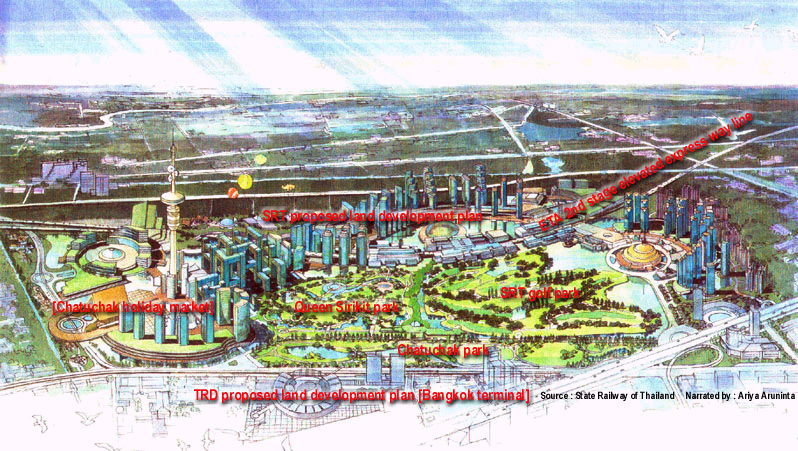The Development of Public Land Management Policy for Under-utilized Spaces in Bangkok, Thailand.
[Find out
|
Slides presentation
PDF files of presentation
|
|
Panoramic view 1 |
the 42nd IFLA World Congress International Conference - Edinburgh, Scotland [June 26-29, 2005] Abstract "MANAGING PUBLICLY OWNED URBAN VACANT LAND REDEVELOPMENT PROJECTS IN BANGKOK, THAILAND" Theme : Quality, Aesthetics and Economics
City Futures International Conference - Chicago, Illinois [July 8-10, 2004] Abstract "CONTROVERSIES IN PUBLIC LAND MANAGEMENT DECISION -MAKINGS : CASE STUDY OF LAND UTILIZATION IN BANGKOK, THAILAND"
Or ..Download full paper from City Futures website [Click here][Learn more about...]
Fulbright Junior Research Scholar Program
2003-2004
at Great Cities Institute, College of Urban Planning and Public Affairs, University of Illinois at Chicago
GCI-CUPPA,UIC
| Panoramic view 2 |
Research Proposal (draft copy dated June20th,2002)
-
Chapter 1 Introduction and statement of the issues.
-
Chapter 2 [Part1] Justification of the research.
-
Chapter 2 [Part2] About the case study of Bangkok,Thailand.
-
Chapter 3 Research design.
|
Referred
to the observation, Thai people life styles have a strong influence
on utilization of urban voids, including the attitudes toward
public activities, culture, hot-humid climate, and outdoor recreations.
Most of Thai people like to spend their leisure time on shopping,
or walking in the department store. Street vendor is also one
of the special characteristic of Thai merchandize. In addition
to the insufficiency of park and public space, Thai people seem
to accommodate the vacant space with their leisure activities
such as informal (mouse holes) street soccer (see panoramic view
1.), badminton, ta-kraw (Rattan ball), sketch boarding ,and Thai
boxing training. Some districts have initiated community activities
during the early morning and evening at the parking lot space
and at the other potential vacant space. The popular community
activities are Tai-kek (Tai-Chi : Chinese style Mind/body exercise)
and aerobic. In addition, ETA gains some small part of their income
from renting the vacant space under the elevated structure for
commercial purpose in the community (see panoramic view 2), rental
is in 1 year contract at the rate of 250-300 Baht/sq.war.
|
|
Urban land management policy for under-utilized space has been the issue discussed among physical urban planners. The definition of under-utilized space includes urban voids, vacant land, which are identified as the problems of city beautification (visual quality) and tidiness, in the meanwhile on the more positive side; those spaces are also the potential of re-development project for economic, social, and environmental purpose. The complication of factors in urban planning has involved several decision-makings; started from determining of objectives, financial feasibility assessment, engineering design, selecting of construction technology, legislation and juridical matter, contracting, construction, and operation. Many of the decisions on land utilization were not one of the main objectives of planning a project, in fact it usually is not indicated clearly in the policy level. Several projects can be found that the involved actors have changed the prior decision-makings from time-to-time without convincing reasons. This has led to the improper and inefficient land use and created urban voids. |
In addition to ETA the study will explore on the other 2 organizations ; TRD (Treasury Dept) and SRT (State Railway of Thailand).
The examples can be given such as the expressway projects, which have been aimed mainly in order to solve traffic congestion problem. The expropriation of the land for expressway construction including the land within the right of way (ROW), under the elevated, flyover structure and ramp causes further problems, since part of the expropriated land had been laid down the expressway system structure, at the same time the left over pieces of land were found vacant. The improper utilized space, trespassing of the squatters and narcotic users, illegal ownership and conflict beneficiary resulted unexpectedly from the plan. These problems have been discussed in the administrative decision-making only in responsible organizations and have been decided as an ad hoc program.
In Bangkok case, the main actor is Expressway and Rapid Transit Authority (ETA); a state enterprise, which was established under the Coup Decree of 290 on November 29, 1972; but the complexity nature of these under-utilized space confronts many involved stakeholders, not only the ETA but also the Bangkok Metropolitan Administration (BMA) and the surround communities. In addition, the aspect of legal issues of ownership and the publicly services are conflicting objective. ETA's policy as one of 'public policy', decision-making process should not rely on only one actor and there should not be only one final solution.
Need more information <mail to me>
Case Study
The selected case study area is Pathonyothin district where locates 3 organizations' under utilized land; SRT, ETA and TRD. TRD and SRT already purposed their plan for land development. Both of them are not yet implemented due to non-feasibility of the projects. [See enlarge format of picture below]
